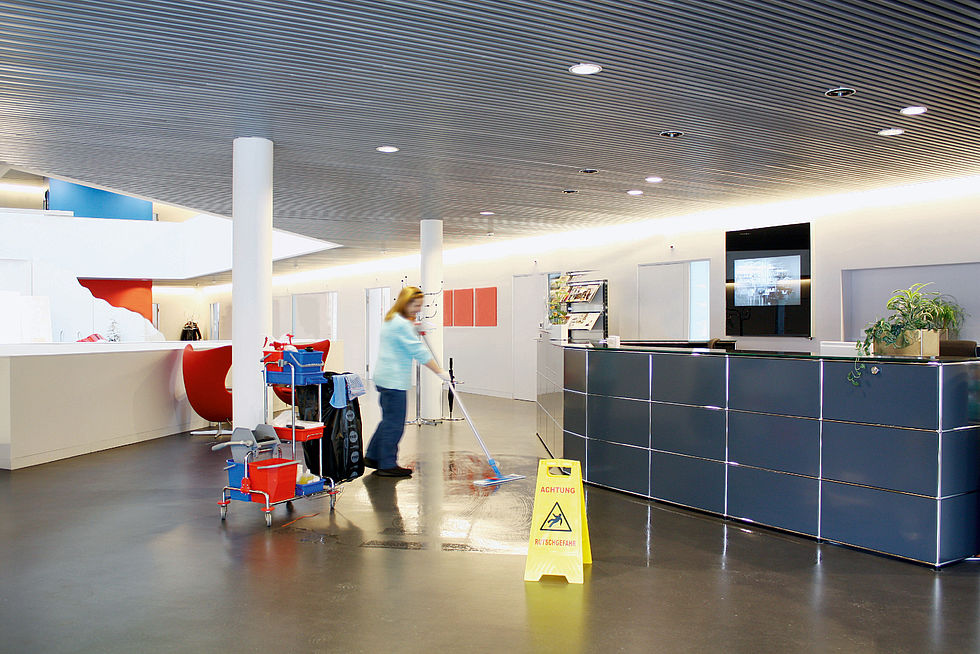


Whether on a construction site or in the office, nobody wants to be involved in an accident or, worse, to actually cause one. To avert such situations wherever possible, a good system is needed that ensures positive collaboration between the employer, employees and occupational safety specialists.
The burden of responsibility for health and safety is carried by the employer. Prevention of accidents at work and protecting the health of the employees are executive tasks and this remains the case even if a safety officer is appointed. The duties of the employer as well as those of employees are regulated by law and based on different sets of laws. In practice, the Accident Insurance Act and Labour Act and their provisions in regard to employee protection are of greatest relevance.1 Both sets of laws as well as the provisions under private law of the Swiss Code of Obligations are almost identical in the wording of their basic principles:2
To protect the health of their employees as well as to avert occupational accidents and work-related illness, employers must take all measures
The most important duties of employers in regard to occupational safety and health protection are derived from the above principles and found in the corresponding provisions. Employers must, among others:
The legal implementing bodies (cantonal work inspectorate, SUVA, SECO) advise employers and check to see if companies are complying with legal requirements. In the case of violations, they take action by issuing a caution or an injunction. Criminal sanctions, for example, for violations that are wilful or due to negligence, are happily more of a rarity in offices.
The motivation for employers to ensure occupational safety and health protection is not limited to legal compliance. Healthy employees are more efficient and motivated. This also pays off from the economic standpoint with fewer absences, lower costs and higher productivity.
Not all businesses are the same. They differ in terms of size and activities. The risks and health hazards also differ from business to business. In order to help employers comply with their obligations, the Federal Coordination Commission of Occupational Safety FCOS has issued the ASA Guidelines.4 They show when a company needs to call on an occupational safety specialist in order to ensure occupational safety and health protection. This is rarely necessary for many businesses in the service sector whose work is carried out primarily in offices where no special risks are posed. This does not, however, release these companies from their responsibility to comply wth legal requirements. In this regard an appropriate safety system is a MUST in order to deal with the risks and health hazards specific to the individual business.
Businesses are at liberty to implement their safety measures individually. However, the necessary expertise to do so may not be available within the company. In its ASA Guidelines, FCOS, therefore, shows how businesses can put together a safety system that is tailored to their individual needs. For small and medium-sized companies in particular, it often makes more sense to join forces with other companies rather than going to the trouble of acquiring the necessary expertise individually or engaging external expert support.
The sector solution is often the ideal solution to occupational safety for many companies. The sponsors of sector solutions make a sector-specific safety system (handbook) and checklists available and offer training as well as other services. There are 80 such FCOS-certified sector solutions today.
Another approach is the model solution. Here the company takes over an existing safety or quality assurance system from an external provider into which occupational safety and health protection have been integrated.
When participating in a multi-company collaboration, the company must nevertheless ensure that it meets its individual operational safety requirements and undertakes any changes that are necessary.
Not only do employers have duties that must be fulfilled, this also applies to employees who must ensure a safe and healthy working environment for themselves as well as for their colleagues. In doing so they must support the employer in carrying out occupational safety and health protection and comply with the requirements. They must abide by the safety guidelines, make correct use of the protective equipment and wear personal protective gear. Defects that might affect occupational safety or health protection must be communicated to the employer or rectified, if authorised to do so
A safety system that is carried by everyone in the company is of practical help to the employer and safety officers towards carrying out their responsibilities and continuously improving the health and safety of the employees within the company.
1 Occupational illnesses VUV and Swiss Federal law in regard to accident insurance and the accompanying regulations on the prevention of accidents and occupational disease as well as the Swiss Federal law regulating work in industry, commerce and trade (Labour Act), the corresponding provisions 1 to 5 of the Labour Act and maternity protection regulations.
2 Cf. Article 82 paragraph 1 Accident Insurance Act, Article 6 Paragraph 1 Labour Law und Article 328 Paragraph 2 Code of Obligations
3 How these principles are to be interpreted, explained and elaborated can be found in «Wegleitung der EKAS durch die Arbeitssicherheit» in point 306 (German).
4 EKAS, „Richtlinie über den Beizug von Arbeitsärzten und anderen Spezialisten der Arbeitssicherheit (ASA-Richtlinie)“, 6508.d